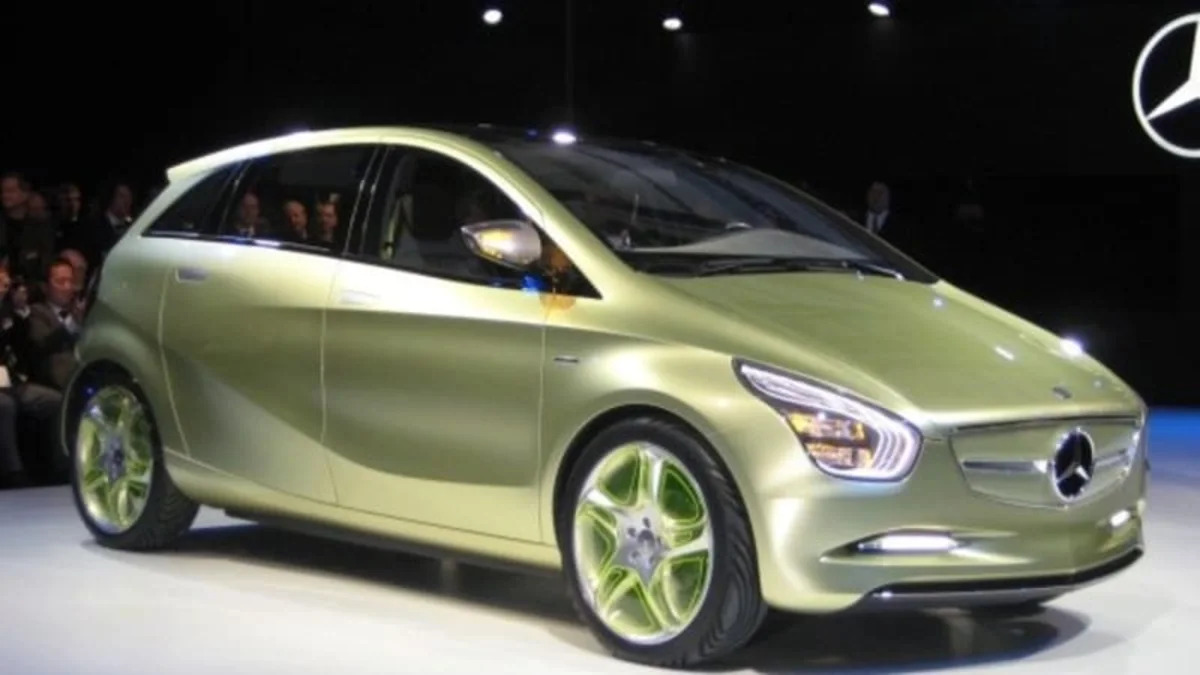Mercedes-Benz concept BlueZero - Click above for high-res image gallery
Just the other day, Mercedes-Benz put its hydrogen-powered F-CELL Roadster concept on the road for the very first time. While that vehicle isn't exactly what you'd call practical for the vast majority of mankind, the German automaker has another hydrogen-powered automobile that's set to make its first public appearance in short order. The new zero-emission vehicle will be based on the B-Class and will reportedly enter small-scale series production before the end of the year.
This little tidbit was briefly mentioned in the automaker's latest press release, which is pasted after the break. We'd expect the fuel-cell B-Class to take inspiration from the Mercedes-Benz BlueZero concept vehicles that made their debuts at the Detroit Auto Show earlier this year.
Daimler also confirmed plans to build a few electric smart fortwo hatchbacks sometime around the end of 2009 for testing under the e-mobility Berlin project.
[Source: Mercedes-Benz]
PRESS RELEASE:
Following the trail of Bertha Benz: F-CELL Roadster on the historic route of Bertha Benz
- Retracing the first long-distance journey in automobile history
- Chemist´s shop in Wiesloch as aiming point
The F-CELL Roadster built by apprentices at the Mercedes-Benz plant in Sindelfingen covered a section of the historic route taken by Bertha Benz on the past weekend. Starting in Mannheim, the fuel cell powered car was driven via Ladenburg and Heidelberg. The symbolic passing of the finish line was at the chemist's shop in Wiesloch, where Bertha Benz stopped to refuel during the first long-distance journey in automobile history in 1888.
"This trip by the F-CELL Roadster is symbolic of the current change taking place in automobile engineering", says Dr. Thomas Weber, the member of the Daimler AG Executive Board responsible for corporate research and development at Mercedes-Benz Cars. "At that time Bertha Benz was not yet able to purchase the petrol she needed at a filling station, and for emission-free mobility we are also dependent on the widespread distribution of fuels for the future – electric power and hydrogen. But just as Bertha Benz refused to be discouraged by inconveniences in her day, we are just as determined to help ensure that these technologies achieve their breakthrough."
Before the end of this year, the company will commence small-series production of the B-Class with a fuel cell drive system. At the end of 2009 the first examples of the smart fortwo electric drive model will also leave the production line to enter service in the "e-mobility Berlin" project early next year.
The F-CELL Roadster
For around one year, more than 150 apprentices and sandwich course students worked on the design, development, assembly and completion of the F- CELL Roadster. The work also involved promising young personnel from the fields of vehicle mechatronics, model-building, electronics, coating technology and production mechanics, as well as product design and interior equipment. The main aim of the project was to integrate the topic of alternative drive systems into the training content in a practical manner.
In a unique way, the vehicle links the very latest technologies with the history of automobile engineering. As a feature reminiscent of the Benz Patent Motor Wagon of 1886, the car is equipped with large, spoked wheels. The F-CELL Roadster also has styling features from a wide range of automotive eras. These include carbon-fibre seat bases with hand-stitched leather upholstery and a striking glass-fibre front end that takes its lead from Formula 1 racing cars.
The car is steered using drive-by-wire technology, a conventional steering wheel giving way to a joystick. It is powered by an emission-free fuel cell system installed in the rear. With an output of 1.2 kW, the F-CELL Roadster is capable of a top speed of 25 km/h with an operating range of up to 350 km.
First long-distance journey in automobile history
In August 1888, Bertha Benz and her two sons made a journey from Mannheim to Pforzheim in the Patent Motor Wagon designed by her husband Carl Benz, returning to Mannheim a few days later. This first long-distance journey in the history of the automobile is acknowledged as a pioneering event. The journey was practically problem-free, with just a few small technical hitches that could all be remedied. The supply of "Ligroin", as petrol was called at the time, gave cause for concern, however, as the 4.5-litre supply in the carburettor – there was no petrol tank as yet – was rapidly dwindling. Ligroin could be purchased from pharmacies in those days, and the town pharmacy in Wiesloch was able to help out. The shop still exists today, and is proud to inform visitors that it was the world's first filling station.


Sign in to post
Please sign in to leave a comment.
Continue